Research Report: HIV/AIDS Stigma, Discrimination, and Impact in Kenya
VerifiedAdded on 2020/03/16
|20
|4872
|86
Report
AI Summary
This research report delves into the pervasive issue of HIV/AIDS stigma and discrimination in Kenya, exploring its impact on individuals and society. The study utilizes a mixed-methods approach, primarily qualitative, to gather data through interviews, group discussions, and questionnaires. The research examines various facets of stigma, including anticipated, perceived, internalized, and experienced stigma, as well as discrimination. The report highlights the challenges faced by HIV-positive individuals, such as social isolation, lack of employment, and psychological distress. It discusses the research methodology, including sampling techniques, data collection, and analysis, emphasizing the importance of understanding the social and environmental context. The findings underscore the need for interventions to reduce stigma, promote social acceptance, and improve the lives of those affected by HIV/AIDS. The report concludes with recommendations for future research and policy changes to address the persistent challenges of stigma and discrimination.

qwertyuiopasdfghjklzxcvbnmqwertyuio
pasdfghjklzxcvbnmqwertyuiopasdfghjkl
zxcvbnmqwertyuiopasdfghjklzxcvbnmq
wertyuiopasdfghjklzxcvbnmqwertyuiop
asdfghjklzxcvbnmqwertyuiopasdfghjklz
xcvbnmqwertyuiopasdfghjklzxcvbnmq
wertyuiopasdfghjklzxcvbnmqwertyuiop
asdfghjklzxcvbnmqwertyuiopasdfghjklz
xcvbnmqwertyuiopasdfghjklzxcvbnmq
wertyuiopasdfghjklzxcvbnmqwertyuiop
asdfghjklzxcvbnmqwertyuiopasdfghjklz
xcvbnmqwertyuiopasdfghjklzxcvbnmq
wertyuiopasdfghjklzxcvbnmqwertyuiop
asdfghjklzxcvbnmrtyuiopasdfghjklzxcvb
nmqwertyuiopasdfghjklzxcvbnmqwerty
uiopasdfghjklzxcvbnmqwertyuiopasdfg
hjklzxcvbnmqwertyuiopasdfghjklzxcvbn
mqwertyuiopasdfghjklzxcvbnmqwertyu
iopasdfghjklzxcvbnmqwertyuiopasdfghj
Business Research Report
pasdfghjklzxcvbnmqwertyuiopasdfghjkl
zxcvbnmqwertyuiopasdfghjklzxcvbnmq
wertyuiopasdfghjklzxcvbnmqwertyuiop
asdfghjklzxcvbnmqwertyuiopasdfghjklz
xcvbnmqwertyuiopasdfghjklzxcvbnmq
wertyuiopasdfghjklzxcvbnmqwertyuiop
asdfghjklzxcvbnmqwertyuiopasdfghjklz
xcvbnmqwertyuiopasdfghjklzxcvbnmq
wertyuiopasdfghjklzxcvbnmqwertyuiop
asdfghjklzxcvbnmqwertyuiopasdfghjklz
xcvbnmqwertyuiopasdfghjklzxcvbnmq
wertyuiopasdfghjklzxcvbnmqwertyuiop
asdfghjklzxcvbnmrtyuiopasdfghjklzxcvb
nmqwertyuiopasdfghjklzxcvbnmqwerty
uiopasdfghjklzxcvbnmqwertyuiopasdfg
hjklzxcvbnmqwertyuiopasdfghjklzxcvbn
mqwertyuiopasdfghjklzxcvbnmqwertyu
iopasdfghjklzxcvbnmqwertyuiopasdfghj
Business Research Report
Paraphrase This Document
Need a fresh take? Get an instant paraphrase of this document with our AI Paraphraser

Research 2
Table of Contents
Introduction ...................................................................................................................................... 2
Research Statement............................................................................................................................ 3
Research Approach............................................................................................................................. 4
Research Questionnaire.................................................................................................................... 7
Research Questions............................................................................................................................. 8
Instruments and Measures.............................................................................................................. 9
Data Collection Method.................................................................................................................. 12
Sampling Procedure.........................................................................................................................13
Data Analysis ................................................................................................................................... 14
Conclusion ................................................................................................................................... 15
References ................................................................................................................................... 18
Table of Contents
Introduction ...................................................................................................................................... 2
Research Statement............................................................................................................................ 3
Research Approach............................................................................................................................. 4
Research Questionnaire.................................................................................................................... 7
Research Questions............................................................................................................................. 8
Instruments and Measures.............................................................................................................. 9
Data Collection Method.................................................................................................................. 12
Sampling Procedure.........................................................................................................................13
Data Analysis ................................................................................................................................... 14
Conclusion ................................................................................................................................... 15
References ................................................................................................................................... 18
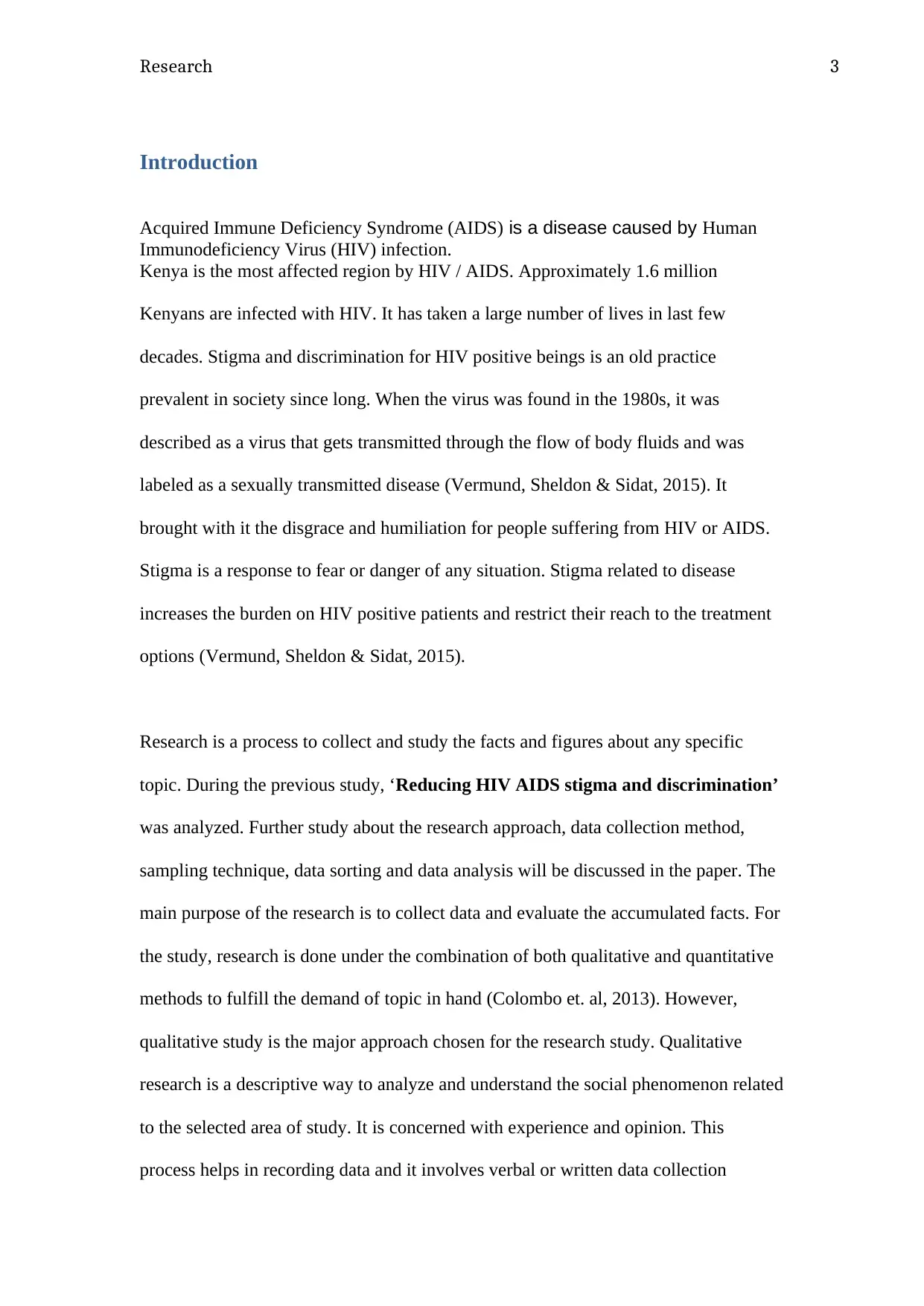
Research 3
Introduction
Acquired Immune Deficiency Syndrome (AIDS) is a disease caused by Human
Immunodeficiency Virus (HIV) infection.
Kenya is the most affected region by HIV / AIDS. Approximately 1.6 million
Kenyans are infected with HIV. It has taken a large number of lives in last few
decades. Stigma and discrimination for HIV positive beings is an old practice
prevalent in society since long. When the virus was found in the 1980s, it was
described as a virus that gets transmitted through the flow of body fluids and was
labeled as a sexually transmitted disease (Vermund, Sheldon & Sidat, 2015). It
brought with it the disgrace and humiliation for people suffering from HIV or AIDS.
Stigma is a response to fear or danger of any situation. Stigma related to disease
increases the burden on HIV positive patients and restrict their reach to the treatment
options (Vermund, Sheldon & Sidat, 2015).
Research is a process to collect and study the facts and figures about any specific
topic. During the previous study, ‘Reducing HIV AIDS stigma and discrimination’
was analyzed. Further study about the research approach, data collection method,
sampling technique, data sorting and data analysis will be discussed in the paper. The
main purpose of the research is to collect data and evaluate the accumulated facts. For
the study, research is done under the combination of both qualitative and quantitative
methods to fulfill the demand of topic in hand (Colombo et. al, 2013). However,
qualitative study is the major approach chosen for the research study. Qualitative
research is a descriptive way to analyze and understand the social phenomenon related
to the selected area of study. It is concerned with experience and opinion. This
process helps in recording data and it involves verbal or written data collection
Introduction
Acquired Immune Deficiency Syndrome (AIDS) is a disease caused by Human
Immunodeficiency Virus (HIV) infection.
Kenya is the most affected region by HIV / AIDS. Approximately 1.6 million
Kenyans are infected with HIV. It has taken a large number of lives in last few
decades. Stigma and discrimination for HIV positive beings is an old practice
prevalent in society since long. When the virus was found in the 1980s, it was
described as a virus that gets transmitted through the flow of body fluids and was
labeled as a sexually transmitted disease (Vermund, Sheldon & Sidat, 2015). It
brought with it the disgrace and humiliation for people suffering from HIV or AIDS.
Stigma is a response to fear or danger of any situation. Stigma related to disease
increases the burden on HIV positive patients and restrict their reach to the treatment
options (Vermund, Sheldon & Sidat, 2015).
Research is a process to collect and study the facts and figures about any specific
topic. During the previous study, ‘Reducing HIV AIDS stigma and discrimination’
was analyzed. Further study about the research approach, data collection method,
sampling technique, data sorting and data analysis will be discussed in the paper. The
main purpose of the research is to collect data and evaluate the accumulated facts. For
the study, research is done under the combination of both qualitative and quantitative
methods to fulfill the demand of topic in hand (Colombo et. al, 2013). However,
qualitative study is the major approach chosen for the research study. Qualitative
research is a descriptive way to analyze and understand the social phenomenon related
to the selected area of study. It is concerned with experience and opinion. This
process helps in recording data and it involves verbal or written data collection
⊘ This is a preview!⊘
Do you want full access?
Subscribe today to unlock all pages.

Trusted by 1+ million students worldwide
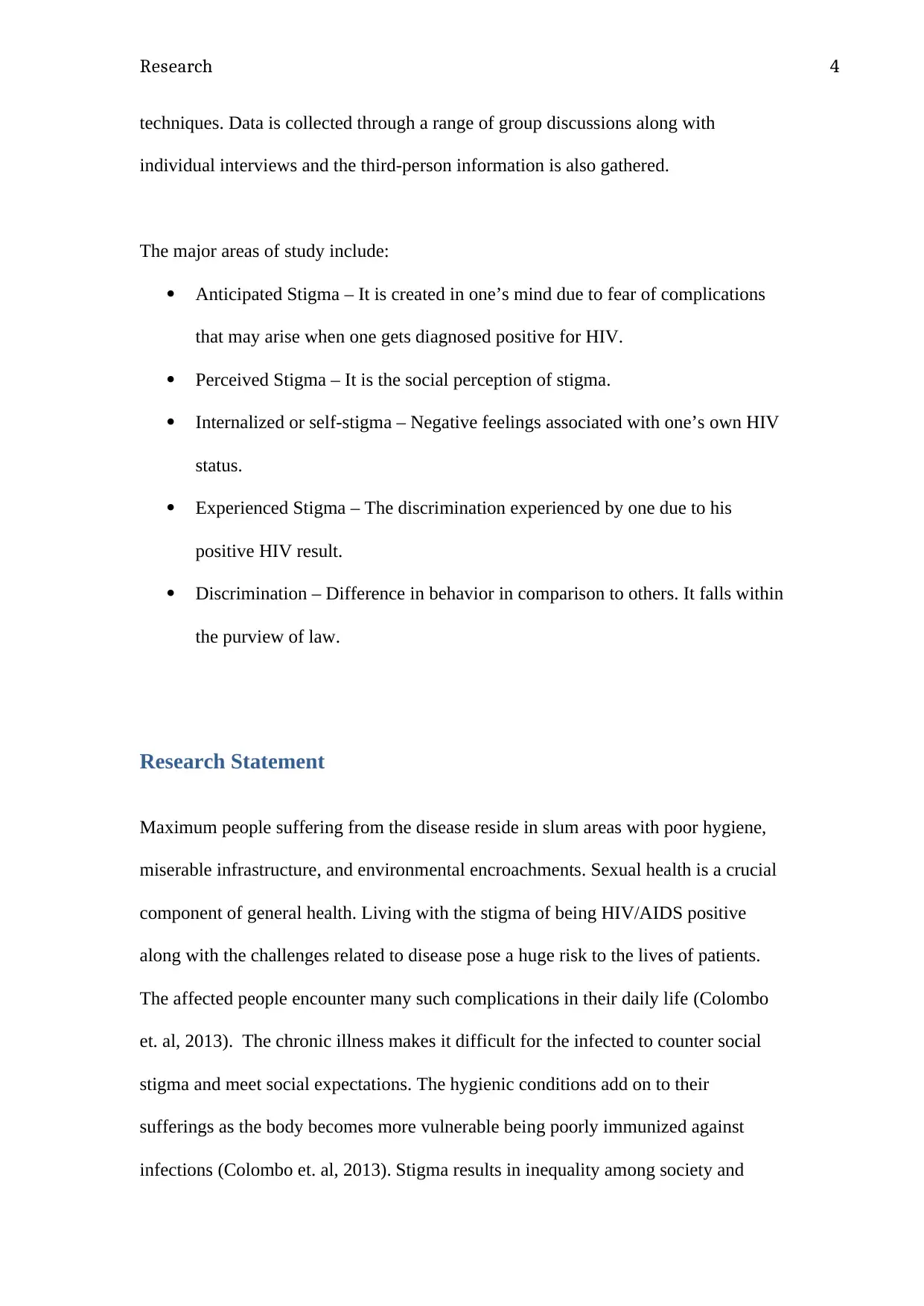
Research 4
techniques. Data is collected through a range of group discussions along with
individual interviews and the third-person information is also gathered.
The major areas of study include:
Anticipated Stigma – It is created in one’s mind due to fear of complications
that may arise when one gets diagnosed positive for HIV.
Perceived Stigma – It is the social perception of stigma.
Internalized or self-stigma – Negative feelings associated with one’s own HIV
status.
Experienced Stigma – The discrimination experienced by one due to his
positive HIV result.
Discrimination – Difference in behavior in comparison to others. It falls within
the purview of law.
Research Statement
Maximum people suffering from the disease reside in slum areas with poor hygiene,
miserable infrastructure, and environmental encroachments. Sexual health is a crucial
component of general health. Living with the stigma of being HIV/AIDS positive
along with the challenges related to disease pose a huge risk to the lives of patients.
The affected people encounter many such complications in their daily life (Colombo
et. al, 2013). The chronic illness makes it difficult for the infected to counter social
stigma and meet social expectations. The hygienic conditions add on to their
sufferings as the body becomes more vulnerable being poorly immunized against
infections (Colombo et. al, 2013). Stigma results in inequality among society and
techniques. Data is collected through a range of group discussions along with
individual interviews and the third-person information is also gathered.
The major areas of study include:
Anticipated Stigma – It is created in one’s mind due to fear of complications
that may arise when one gets diagnosed positive for HIV.
Perceived Stigma – It is the social perception of stigma.
Internalized or self-stigma – Negative feelings associated with one’s own HIV
status.
Experienced Stigma – The discrimination experienced by one due to his
positive HIV result.
Discrimination – Difference in behavior in comparison to others. It falls within
the purview of law.
Research Statement
Maximum people suffering from the disease reside in slum areas with poor hygiene,
miserable infrastructure, and environmental encroachments. Sexual health is a crucial
component of general health. Living with the stigma of being HIV/AIDS positive
along with the challenges related to disease pose a huge risk to the lives of patients.
The affected people encounter many such complications in their daily life (Colombo
et. al, 2013). The chronic illness makes it difficult for the infected to counter social
stigma and meet social expectations. The hygienic conditions add on to their
sufferings as the body becomes more vulnerable being poorly immunized against
infections (Colombo et. al, 2013). Stigma results in inequality among society and
Paraphrase This Document
Need a fresh take? Get an instant paraphrase of this document with our AI Paraphraser
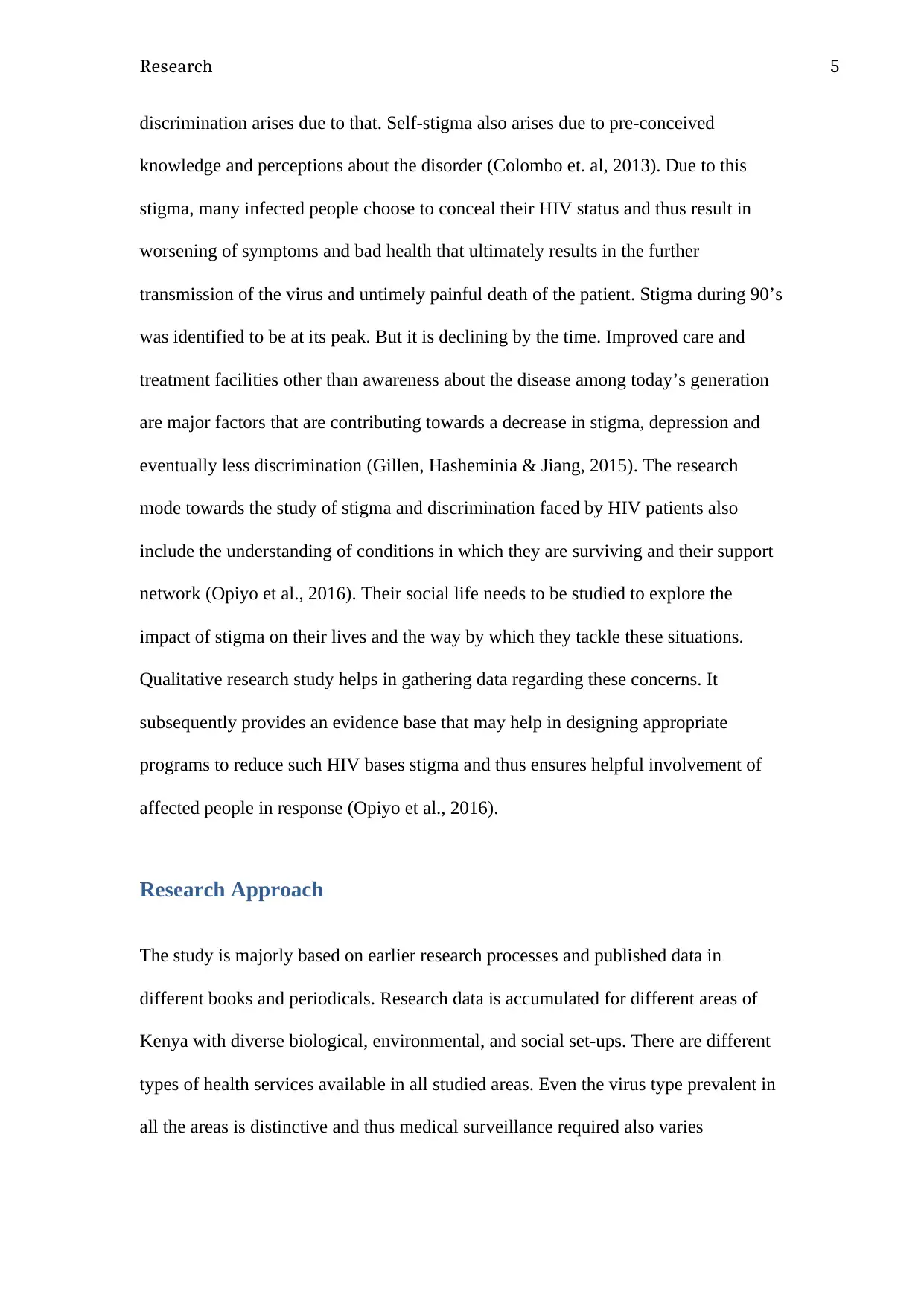
Research 5
discrimination arises due to that. Self-stigma also arises due to pre-conceived
knowledge and perceptions about the disorder (Colombo et. al, 2013). Due to this
stigma, many infected people choose to conceal their HIV status and thus result in
worsening of symptoms and bad health that ultimately results in the further
transmission of the virus and untimely painful death of the patient. Stigma during 90’s
was identified to be at its peak. But it is declining by the time. Improved care and
treatment facilities other than awareness about the disease among today’s generation
are major factors that are contributing towards a decrease in stigma, depression and
eventually less discrimination (Gillen, Hasheminia & Jiang, 2015). The research
mode towards the study of stigma and discrimination faced by HIV patients also
include the understanding of conditions in which they are surviving and their support
network (Opiyo et al., 2016). Their social life needs to be studied to explore the
impact of stigma on their lives and the way by which they tackle these situations.
Qualitative research study helps in gathering data regarding these concerns. It
subsequently provides an evidence base that may help in designing appropriate
programs to reduce such HIV bases stigma and thus ensures helpful involvement of
affected people in response (Opiyo et al., 2016).
Research Approach
The study is majorly based on earlier research processes and published data in
different books and periodicals. Research data is accumulated for different areas of
Kenya with diverse biological, environmental, and social set-ups. There are different
types of health services available in all studied areas. Even the virus type prevalent in
all the areas is distinctive and thus medical surveillance required also varies
discrimination arises due to that. Self-stigma also arises due to pre-conceived
knowledge and perceptions about the disorder (Colombo et. al, 2013). Due to this
stigma, many infected people choose to conceal their HIV status and thus result in
worsening of symptoms and bad health that ultimately results in the further
transmission of the virus and untimely painful death of the patient. Stigma during 90’s
was identified to be at its peak. But it is declining by the time. Improved care and
treatment facilities other than awareness about the disease among today’s generation
are major factors that are contributing towards a decrease in stigma, depression and
eventually less discrimination (Gillen, Hasheminia & Jiang, 2015). The research
mode towards the study of stigma and discrimination faced by HIV patients also
include the understanding of conditions in which they are surviving and their support
network (Opiyo et al., 2016). Their social life needs to be studied to explore the
impact of stigma on their lives and the way by which they tackle these situations.
Qualitative research study helps in gathering data regarding these concerns. It
subsequently provides an evidence base that may help in designing appropriate
programs to reduce such HIV bases stigma and thus ensures helpful involvement of
affected people in response (Opiyo et al., 2016).
Research Approach
The study is majorly based on earlier research processes and published data in
different books and periodicals. Research data is accumulated for different areas of
Kenya with diverse biological, environmental, and social set-ups. There are different
types of health services available in all studied areas. Even the virus type prevalent in
all the areas is distinctive and thus medical surveillance required also varies
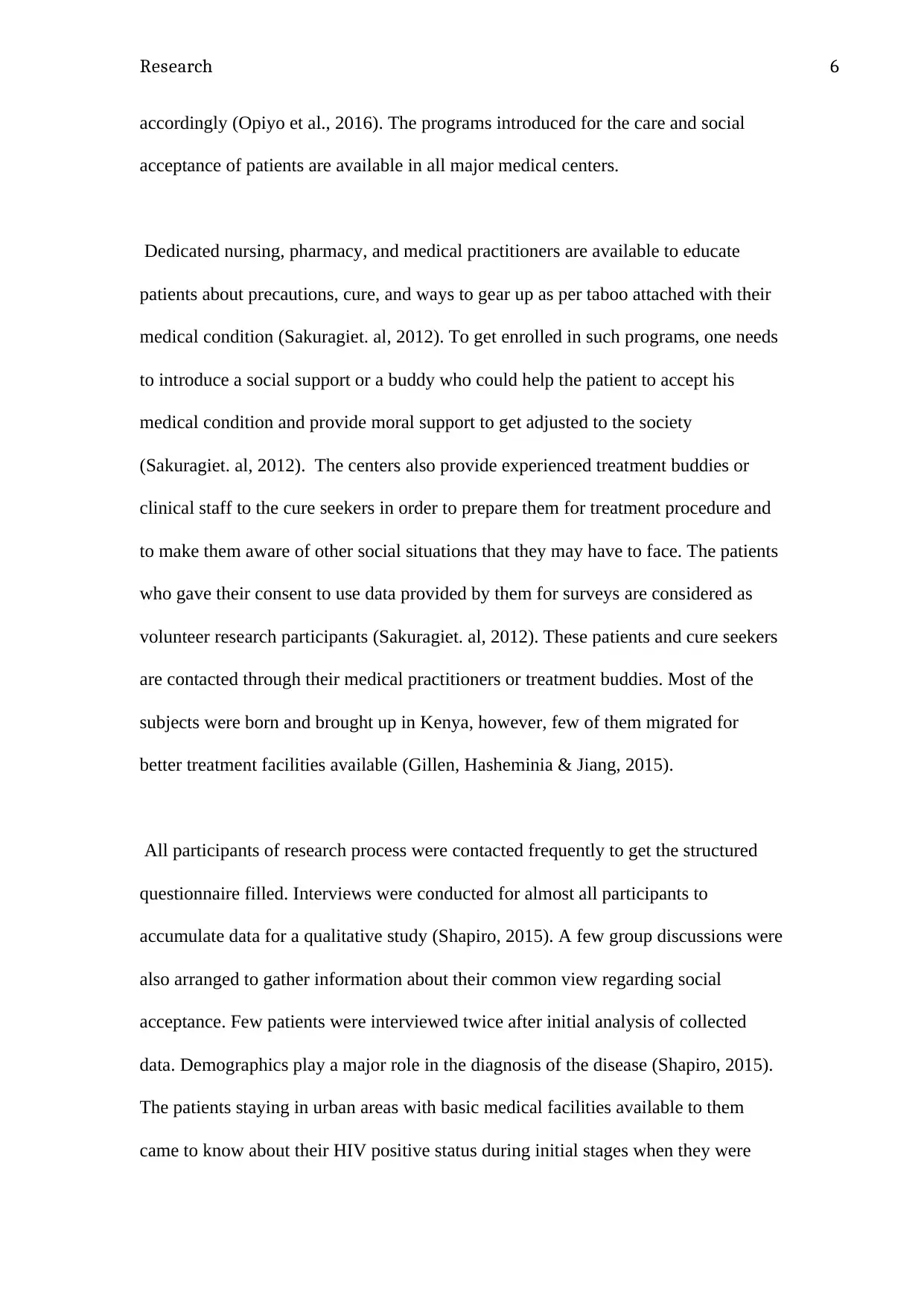
Research 6
accordingly (Opiyo et al., 2016). The programs introduced for the care and social
acceptance of patients are available in all major medical centers.
Dedicated nursing, pharmacy, and medical practitioners are available to educate
patients about precautions, cure, and ways to gear up as per taboo attached with their
medical condition (Sakuragiet. al, 2012). To get enrolled in such programs, one needs
to introduce a social support or a buddy who could help the patient to accept his
medical condition and provide moral support to get adjusted to the society
(Sakuragiet. al, 2012). The centers also provide experienced treatment buddies or
clinical staff to the cure seekers in order to prepare them for treatment procedure and
to make them aware of other social situations that they may have to face. The patients
who gave their consent to use data provided by them for surveys are considered as
volunteer research participants (Sakuragiet. al, 2012). These patients and cure seekers
are contacted through their medical practitioners or treatment buddies. Most of the
subjects were born and brought up in Kenya, however, few of them migrated for
better treatment facilities available (Gillen, Hasheminia & Jiang, 2015).
All participants of research process were contacted frequently to get the structured
questionnaire filled. Interviews were conducted for almost all participants to
accumulate data for a qualitative study (Shapiro, 2015). A few group discussions were
also arranged to gather information about their common view regarding social
acceptance. Few patients were interviewed twice after initial analysis of collected
data. Demographics play a major role in the diagnosis of the disease (Shapiro, 2015).
The patients staying in urban areas with basic medical facilities available to them
came to know about their HIV positive status during initial stages when they were
accordingly (Opiyo et al., 2016). The programs introduced for the care and social
acceptance of patients are available in all major medical centers.
Dedicated nursing, pharmacy, and medical practitioners are available to educate
patients about precautions, cure, and ways to gear up as per taboo attached with their
medical condition (Sakuragiet. al, 2012). To get enrolled in such programs, one needs
to introduce a social support or a buddy who could help the patient to accept his
medical condition and provide moral support to get adjusted to the society
(Sakuragiet. al, 2012). The centers also provide experienced treatment buddies or
clinical staff to the cure seekers in order to prepare them for treatment procedure and
to make them aware of other social situations that they may have to face. The patients
who gave their consent to use data provided by them for surveys are considered as
volunteer research participants (Sakuragiet. al, 2012). These patients and cure seekers
are contacted through their medical practitioners or treatment buddies. Most of the
subjects were born and brought up in Kenya, however, few of them migrated for
better treatment facilities available (Gillen, Hasheminia & Jiang, 2015).
All participants of research process were contacted frequently to get the structured
questionnaire filled. Interviews were conducted for almost all participants to
accumulate data for a qualitative study (Shapiro, 2015). A few group discussions were
also arranged to gather information about their common view regarding social
acceptance. Few patients were interviewed twice after initial analysis of collected
data. Demographics play a major role in the diagnosis of the disease (Shapiro, 2015).
The patients staying in urban areas with basic medical facilities available to them
came to know about their HIV positive status during initial stages when they were
⊘ This is a preview!⊘
Do you want full access?
Subscribe today to unlock all pages.

Trusted by 1+ million students worldwide
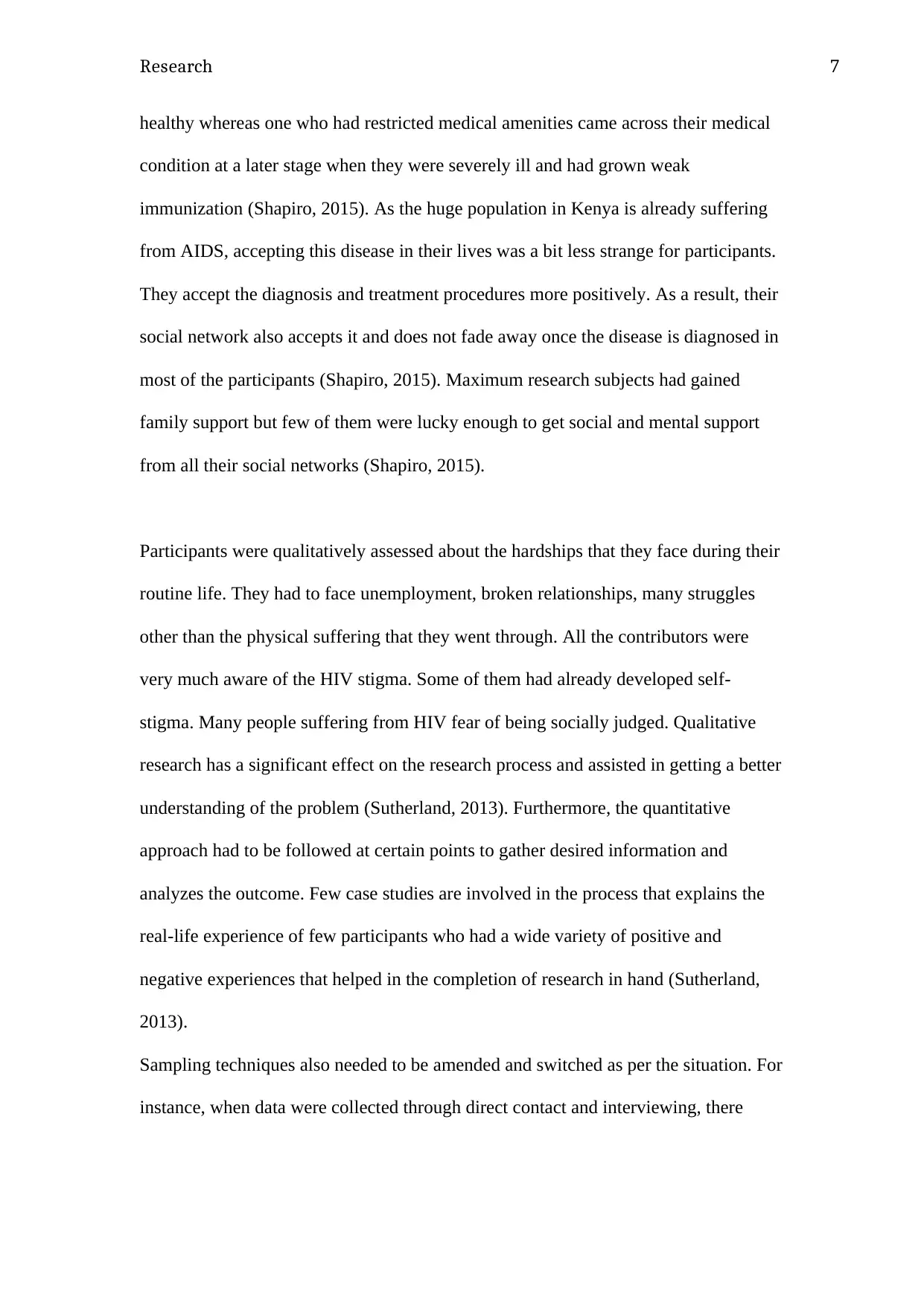
Research 7
healthy whereas one who had restricted medical amenities came across their medical
condition at a later stage when they were severely ill and had grown weak
immunization (Shapiro, 2015). As the huge population in Kenya is already suffering
from AIDS, accepting this disease in their lives was a bit less strange for participants.
They accept the diagnosis and treatment procedures more positively. As a result, their
social network also accepts it and does not fade away once the disease is diagnosed in
most of the participants (Shapiro, 2015). Maximum research subjects had gained
family support but few of them were lucky enough to get social and mental support
from all their social networks (Shapiro, 2015).
Participants were qualitatively assessed about the hardships that they face during their
routine life. They had to face unemployment, broken relationships, many struggles
other than the physical suffering that they went through. All the contributors were
very much aware of the HIV stigma. Some of them had already developed self-
stigma. Many people suffering from HIV fear of being socially judged. Qualitative
research has a significant effect on the research process and assisted in getting a better
understanding of the problem (Sutherland, 2013). Furthermore, the quantitative
approach had to be followed at certain points to gather desired information and
analyzes the outcome. Few case studies are involved in the process that explains the
real-life experience of few participants who had a wide variety of positive and
negative experiences that helped in the completion of research in hand (Sutherland,
2013).
Sampling techniques also needed to be amended and switched as per the situation. For
instance, when data were collected through direct contact and interviewing, there
healthy whereas one who had restricted medical amenities came across their medical
condition at a later stage when they were severely ill and had grown weak
immunization (Shapiro, 2015). As the huge population in Kenya is already suffering
from AIDS, accepting this disease in their lives was a bit less strange for participants.
They accept the diagnosis and treatment procedures more positively. As a result, their
social network also accepts it and does not fade away once the disease is diagnosed in
most of the participants (Shapiro, 2015). Maximum research subjects had gained
family support but few of them were lucky enough to get social and mental support
from all their social networks (Shapiro, 2015).
Participants were qualitatively assessed about the hardships that they face during their
routine life. They had to face unemployment, broken relationships, many struggles
other than the physical suffering that they went through. All the contributors were
very much aware of the HIV stigma. Some of them had already developed self-
stigma. Many people suffering from HIV fear of being socially judged. Qualitative
research has a significant effect on the research process and assisted in getting a better
understanding of the problem (Sutherland, 2013). Furthermore, the quantitative
approach had to be followed at certain points to gather desired information and
analyzes the outcome. Few case studies are involved in the process that explains the
real-life experience of few participants who had a wide variety of positive and
negative experiences that helped in the completion of research in hand (Sutherland,
2013).
Sampling techniques also needed to be amended and switched as per the situation. For
instance, when data were collected through direct contact and interviewing, there
Paraphrase This Document
Need a fresh take? Get an instant paraphrase of this document with our AI Paraphraser
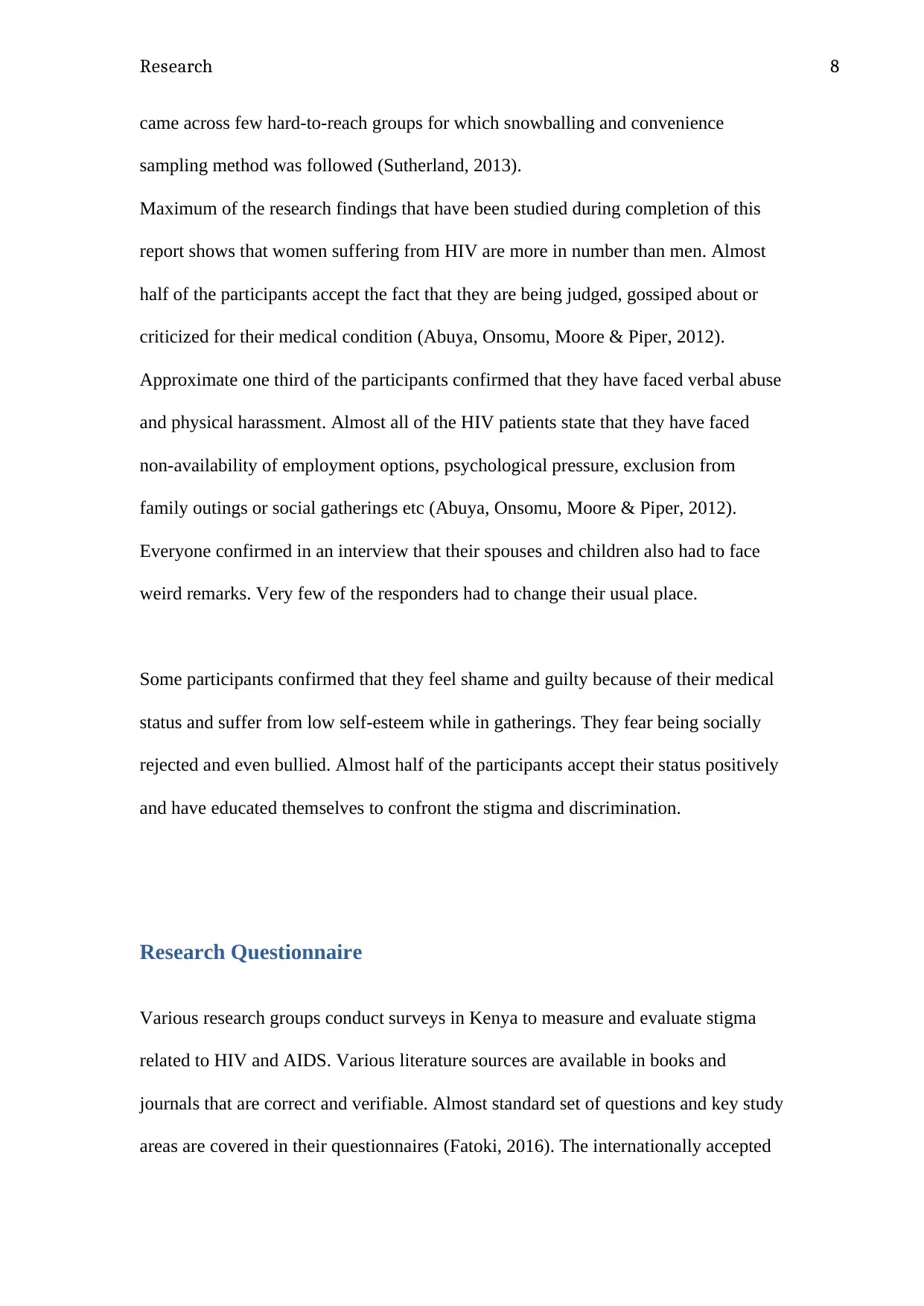
Research 8
came across few hard-to-reach groups for which snowballing and convenience
sampling method was followed (Sutherland, 2013).
Maximum of the research findings that have been studied during completion of this
report shows that women suffering from HIV are more in number than men. Almost
half of the participants accept the fact that they are being judged, gossiped about or
criticized for their medical condition (Abuya, Onsomu, Moore & Piper, 2012).
Approximate one third of the participants confirmed that they have faced verbal abuse
and physical harassment. Almost all of the HIV patients state that they have faced
non-availability of employment options, psychological pressure, exclusion from
family outings or social gatherings etc (Abuya, Onsomu, Moore & Piper, 2012).
Everyone confirmed in an interview that their spouses and children also had to face
weird remarks. Very few of the responders had to change their usual place.
Some participants confirmed that they feel shame and guilty because of their medical
status and suffer from low self-esteem while in gatherings. They fear being socially
rejected and even bullied. Almost half of the participants accept their status positively
and have educated themselves to confront the stigma and discrimination.
Research Questionnaire
Various research groups conduct surveys in Kenya to measure and evaluate stigma
related to HIV and AIDS. Various literature sources are available in books and
journals that are correct and verifiable. Almost standard set of questions and key study
areas are covered in their questionnaires (Fatoki, 2016). The internationally accepted
came across few hard-to-reach groups for which snowballing and convenience
sampling method was followed (Sutherland, 2013).
Maximum of the research findings that have been studied during completion of this
report shows that women suffering from HIV are more in number than men. Almost
half of the participants accept the fact that they are being judged, gossiped about or
criticized for their medical condition (Abuya, Onsomu, Moore & Piper, 2012).
Approximate one third of the participants confirmed that they have faced verbal abuse
and physical harassment. Almost all of the HIV patients state that they have faced
non-availability of employment options, psychological pressure, exclusion from
family outings or social gatherings etc (Abuya, Onsomu, Moore & Piper, 2012).
Everyone confirmed in an interview that their spouses and children also had to face
weird remarks. Very few of the responders had to change their usual place.
Some participants confirmed that they feel shame and guilty because of their medical
status and suffer from low self-esteem while in gatherings. They fear being socially
rejected and even bullied. Almost half of the participants accept their status positively
and have educated themselves to confront the stigma and discrimination.
Research Questionnaire
Various research groups conduct surveys in Kenya to measure and evaluate stigma
related to HIV and AIDS. Various literature sources are available in books and
journals that are correct and verifiable. Almost standard set of questions and key study
areas are covered in their questionnaires (Fatoki, 2016). The internationally accepted
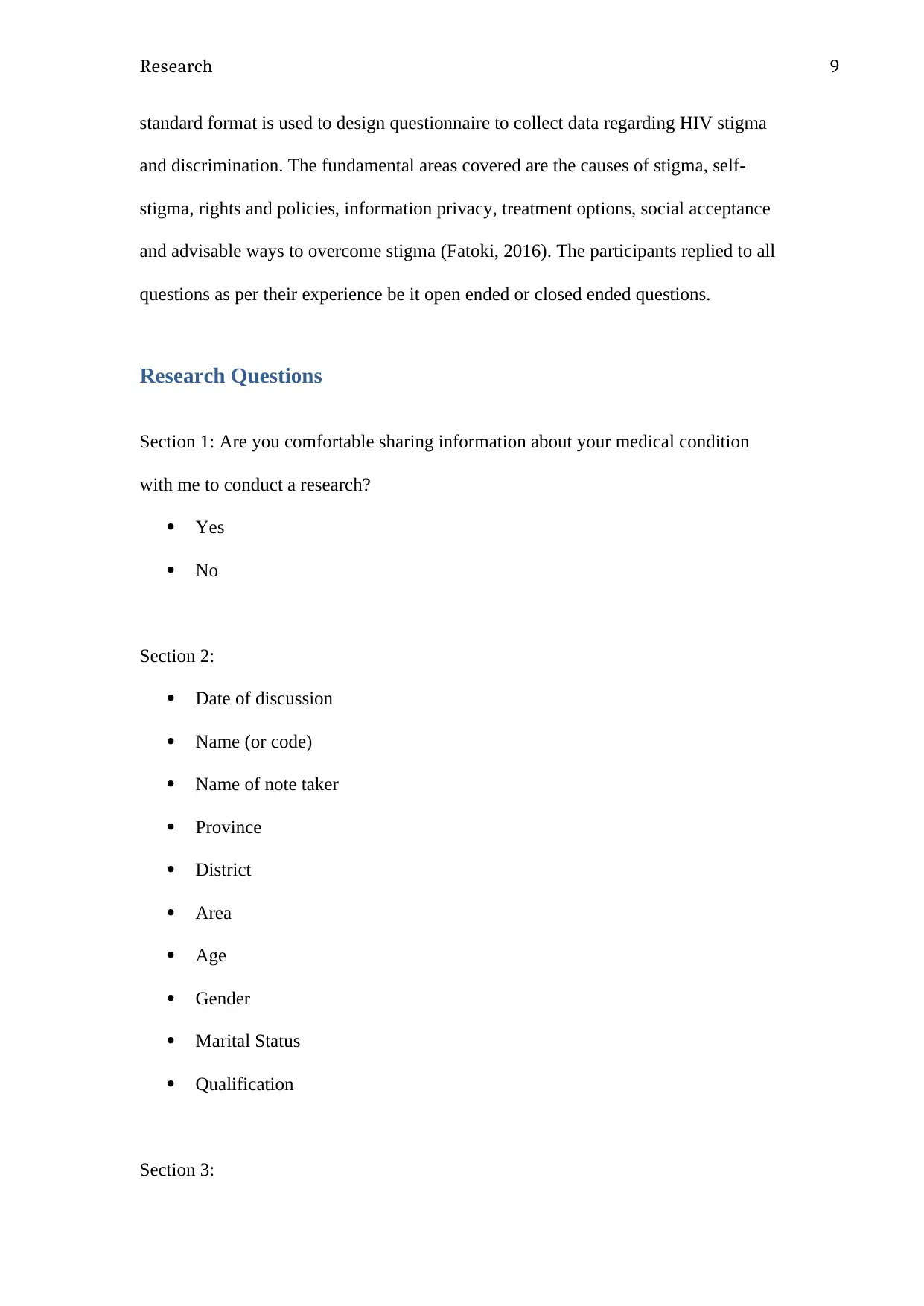
Research 9
standard format is used to design questionnaire to collect data regarding HIV stigma
and discrimination. The fundamental areas covered are the causes of stigma, self-
stigma, rights and policies, information privacy, treatment options, social acceptance
and advisable ways to overcome stigma (Fatoki, 2016). The participants replied to all
questions as per their experience be it open ended or closed ended questions.
Research Questions
Section 1: Are you comfortable sharing information about your medical condition
with me to conduct a research?
Yes
No
Section 2:
Date of discussion
Name (or code)
Name of note taker
Province
District
Area
Age
Gender
Marital Status
Qualification
Section 3:
standard format is used to design questionnaire to collect data regarding HIV stigma
and discrimination. The fundamental areas covered are the causes of stigma, self-
stigma, rights and policies, information privacy, treatment options, social acceptance
and advisable ways to overcome stigma (Fatoki, 2016). The participants replied to all
questions as per their experience be it open ended or closed ended questions.
Research Questions
Section 1: Are you comfortable sharing information about your medical condition
with me to conduct a research?
Yes
No
Section 2:
Date of discussion
Name (or code)
Name of note taker
Province
District
Area
Age
Gender
Marital Status
Qualification
Section 3:
⊘ This is a preview!⊘
Do you want full access?
Subscribe today to unlock all pages.

Trusted by 1+ million students worldwide
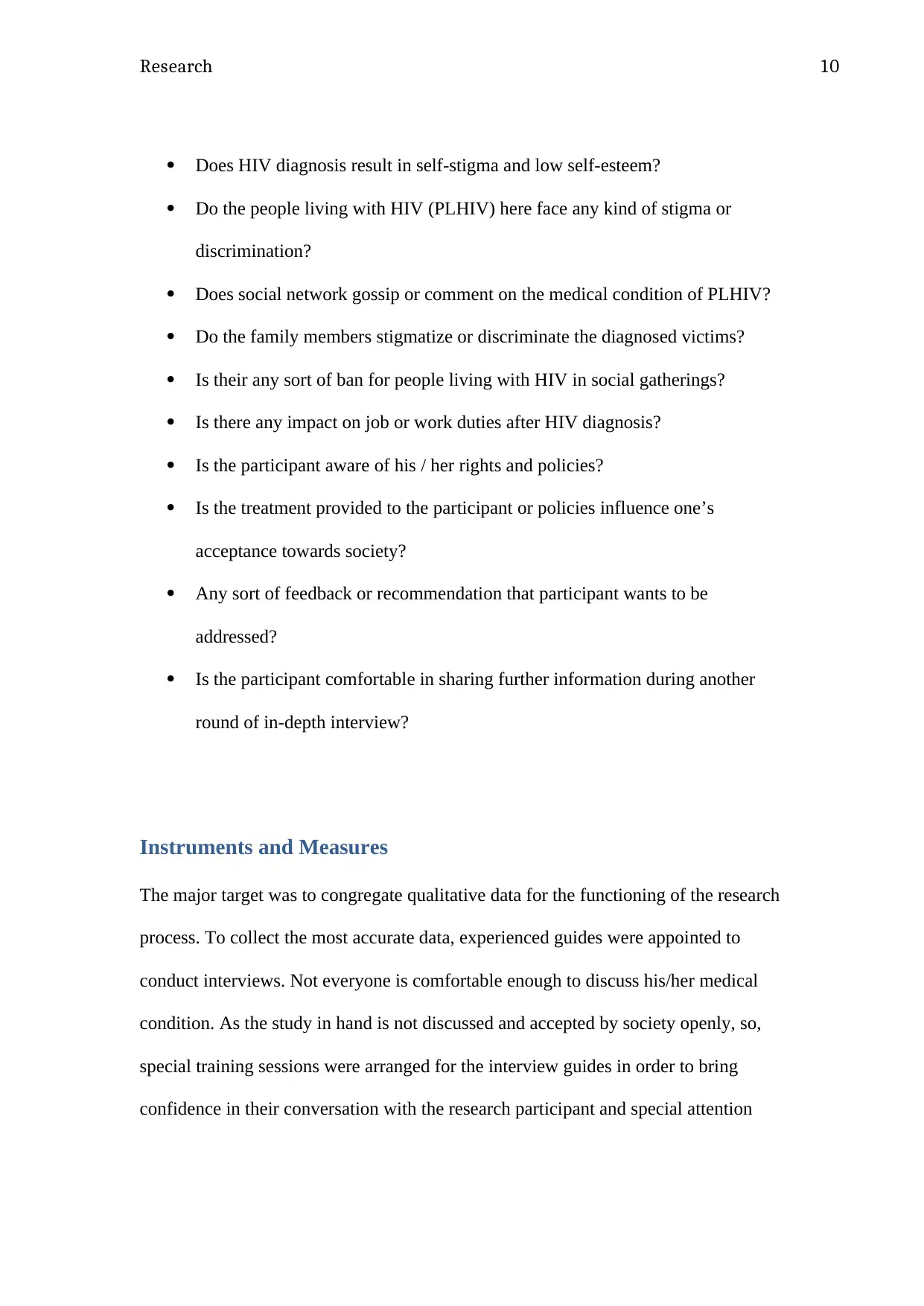
Research 10
Does HIV diagnosis result in self-stigma and low self-esteem?
Do the people living with HIV (PLHIV) here face any kind of stigma or
discrimination?
Does social network gossip or comment on the medical condition of PLHIV?
Do the family members stigmatize or discriminate the diagnosed victims?
Is their any sort of ban for people living with HIV in social gatherings?
Is there any impact on job or work duties after HIV diagnosis?
Is the participant aware of his / her rights and policies?
Is the treatment provided to the participant or policies influence one’s
acceptance towards society?
Any sort of feedback or recommendation that participant wants to be
addressed?
Is the participant comfortable in sharing further information during another
round of in-depth interview?
Instruments and Measures
The major target was to congregate qualitative data for the functioning of the research
process. To collect the most accurate data, experienced guides were appointed to
conduct interviews. Not everyone is comfortable enough to discuss his/her medical
condition. As the study in hand is not discussed and accepted by society openly, so,
special training sessions were arranged for the interview guides in order to bring
confidence in their conversation with the research participant and special attention
Does HIV diagnosis result in self-stigma and low self-esteem?
Do the people living with HIV (PLHIV) here face any kind of stigma or
discrimination?
Does social network gossip or comment on the medical condition of PLHIV?
Do the family members stigmatize or discriminate the diagnosed victims?
Is their any sort of ban for people living with HIV in social gatherings?
Is there any impact on job or work duties after HIV diagnosis?
Is the participant aware of his / her rights and policies?
Is the treatment provided to the participant or policies influence one’s
acceptance towards society?
Any sort of feedback or recommendation that participant wants to be
addressed?
Is the participant comfortable in sharing further information during another
round of in-depth interview?
Instruments and Measures
The major target was to congregate qualitative data for the functioning of the research
process. To collect the most accurate data, experienced guides were appointed to
conduct interviews. Not everyone is comfortable enough to discuss his/her medical
condition. As the study in hand is not discussed and accepted by society openly, so,
special training sessions were arranged for the interview guides in order to bring
confidence in their conversation with the research participant and special attention
Paraphrase This Document
Need a fresh take? Get an instant paraphrase of this document with our AI Paraphraser
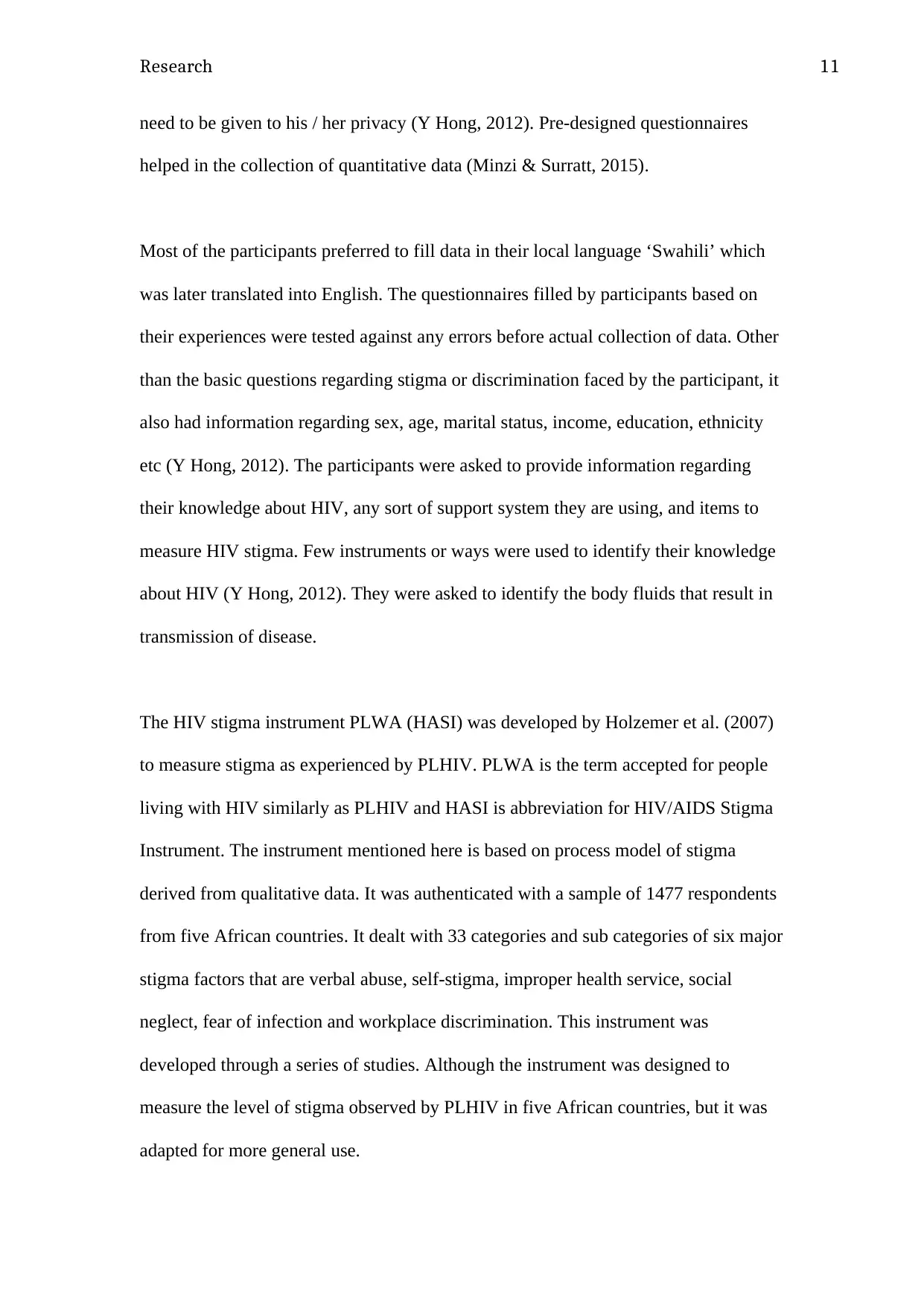
Research 11
need to be given to his / her privacy (Y Hong, 2012). Pre-designed questionnaires
helped in the collection of quantitative data (Minzi & Surratt, 2015).
Most of the participants preferred to fill data in their local language ‘Swahili’ which
was later translated into English. The questionnaires filled by participants based on
their experiences were tested against any errors before actual collection of data. Other
than the basic questions regarding stigma or discrimination faced by the participant, it
also had information regarding sex, age, marital status, income, education, ethnicity
etc (Y Hong, 2012). The participants were asked to provide information regarding
their knowledge about HIV, any sort of support system they are using, and items to
measure HIV stigma. Few instruments or ways were used to identify their knowledge
about HIV (Y Hong, 2012). They were asked to identify the body fluids that result in
transmission of disease.
The HIV stigma instrument PLWA (HASI) was developed by Holzemer et al. (2007)
to measure stigma as experienced by PLHIV. PLWA is the term accepted for people
living with HIV similarly as PLHIV and HASI is abbreviation for HIV/AIDS Stigma
Instrument. The instrument mentioned here is based on process model of stigma
derived from qualitative data. It was authenticated with a sample of 1477 respondents
from five African countries. It dealt with 33 categories and sub categories of six major
stigma factors that are verbal abuse, self-stigma, improper health service, social
neglect, fear of infection and workplace discrimination. This instrument was
developed through a series of studies. Although the instrument was designed to
measure the level of stigma observed by PLHIV in five African countries, but it was
adapted for more general use.
need to be given to his / her privacy (Y Hong, 2012). Pre-designed questionnaires
helped in the collection of quantitative data (Minzi & Surratt, 2015).
Most of the participants preferred to fill data in their local language ‘Swahili’ which
was later translated into English. The questionnaires filled by participants based on
their experiences were tested against any errors before actual collection of data. Other
than the basic questions regarding stigma or discrimination faced by the participant, it
also had information regarding sex, age, marital status, income, education, ethnicity
etc (Y Hong, 2012). The participants were asked to provide information regarding
their knowledge about HIV, any sort of support system they are using, and items to
measure HIV stigma. Few instruments or ways were used to identify their knowledge
about HIV (Y Hong, 2012). They were asked to identify the body fluids that result in
transmission of disease.
The HIV stigma instrument PLWA (HASI) was developed by Holzemer et al. (2007)
to measure stigma as experienced by PLHIV. PLWA is the term accepted for people
living with HIV similarly as PLHIV and HASI is abbreviation for HIV/AIDS Stigma
Instrument. The instrument mentioned here is based on process model of stigma
derived from qualitative data. It was authenticated with a sample of 1477 respondents
from five African countries. It dealt with 33 categories and sub categories of six major
stigma factors that are verbal abuse, self-stigma, improper health service, social
neglect, fear of infection and workplace discrimination. This instrument was
developed through a series of studies. Although the instrument was designed to
measure the level of stigma observed by PLHIV in five African countries, but it was
adapted for more general use.
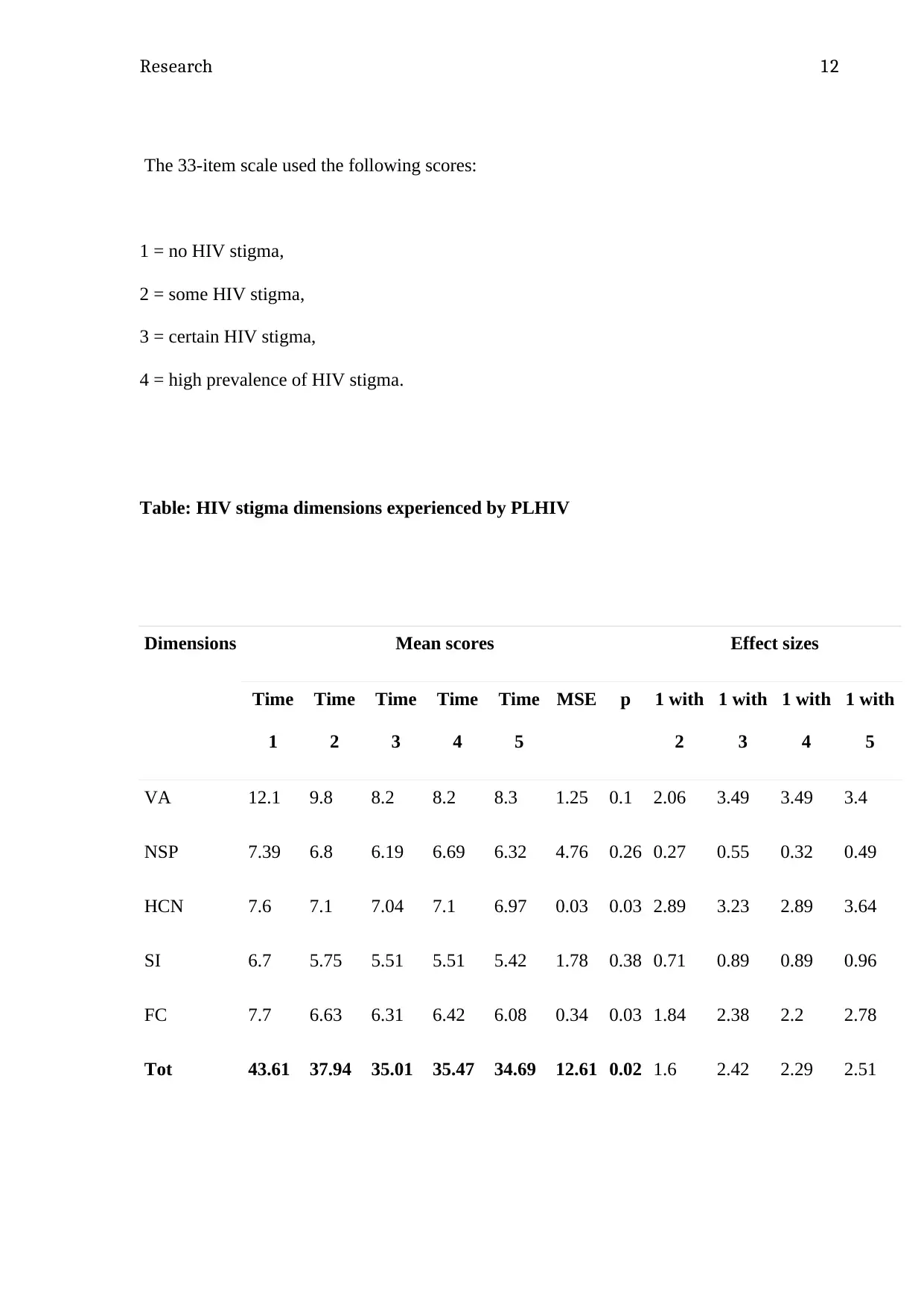
Research 12
The 33-item scale used the following scores:
1 = no HIV stigma,
2 = some HIV stigma,
3 = certain HIV stigma,
4 = high prevalence of HIV stigma.
Table: HIV stigma dimensions experienced by PLHIV
Dimensions Mean scores Effect sizes
Time
1
Time
2
Time
3
Time
4
Time
5
MSE p 1 with
2
1 with
3
1 with
4
1 with
5
VA 12.1 9.8 8.2 8.2 8.3 1.25 0.1 2.06 3.49 3.49 3.4
NSP 7.39 6.8 6.19 6.69 6.32 4.76 0.26 0.27 0.55 0.32 0.49
HCN 7.6 7.1 7.04 7.1 6.97 0.03 0.03 2.89 3.23 2.89 3.64
SI 6.7 5.75 5.51 5.51 5.42 1.78 0.38 0.71 0.89 0.89 0.96
FC 7.7 6.63 6.31 6.42 6.08 0.34 0.03 1.84 2.38 2.2 2.78
Tot 43.61 37.94 35.01 35.47 34.69 12.61 0.02 1.6 2.42 2.29 2.51
The 33-item scale used the following scores:
1 = no HIV stigma,
2 = some HIV stigma,
3 = certain HIV stigma,
4 = high prevalence of HIV stigma.
Table: HIV stigma dimensions experienced by PLHIV
Dimensions Mean scores Effect sizes
Time
1
Time
2
Time
3
Time
4
Time
5
MSE p 1 with
2
1 with
3
1 with
4
1 with
5
VA 12.1 9.8 8.2 8.2 8.3 1.25 0.1 2.06 3.49 3.49 3.4
NSP 7.39 6.8 6.19 6.69 6.32 4.76 0.26 0.27 0.55 0.32 0.49
HCN 7.6 7.1 7.04 7.1 6.97 0.03 0.03 2.89 3.23 2.89 3.64
SI 6.7 5.75 5.51 5.51 5.42 1.78 0.38 0.71 0.89 0.89 0.96
FC 7.7 6.63 6.31 6.42 6.08 0.34 0.03 1.84 2.38 2.2 2.78
Tot 43.61 37.94 35.01 35.47 34.69 12.61 0.02 1.6 2.42 2.29 2.51
⊘ This is a preview!⊘
Do you want full access?
Subscribe today to unlock all pages.

Trusted by 1+ million students worldwide
1 out of 20
Related Documents
Your All-in-One AI-Powered Toolkit for Academic Success.
+13062052269
info@desklib.com
Available 24*7 on WhatsApp / Email
![[object Object]](/_next/static/media/star-bottom.7253800d.svg)
Unlock your academic potential
Copyright © 2020–2025 A2Z Services. All Rights Reserved. Developed and managed by ZUCOL.





